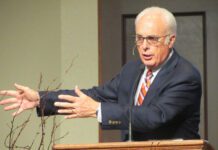Evangelical Christians have been especially attentive to worship in recent years, sparking a renaissance of thought and conversation about what worship really is and how it should be done. Even if this renewed interest has resulted in what some unfortunately have called the worship wars in some churches, it seems that what A.W. Tozer once called the missing jewel of evangelical worship is being recovered.
Nevertheless, if most evangelicals would agree quickly that worship is central to the life of the church, there would be no consensus to an unavoidable question: What is central to Christian worship? Historically, the more liturgical churches have argued that the sacraments form the heart of Christian worship. These churches argue that the elements of the Lord’s Supper and the water of baptism most powerfully present the gospel. Among evangelicals, some call for evangelism as the heart of worship, planning every facet of the service—songs, prayers, the sermon—with the evangelistic invitation in mind.
Though most evangelicals mention the preaching of the Word as a necessary or customary part of worship, the prevailing model of worship in evangelical churches is increasingly defined by music, along with innovations such as drama and video presentations. When preaching the Word retreats, a host of entertaining innovations will take its place.
Traditional norms of worship are now subordinated to a demand for relevance and creativity. A media-driven culture of images has replaced the Word-centered culture that gave birth to the Reformation churches. In some sense, the image-driven culture of modern evangelicalism is an embrace of the very practices rejected by the Reformers in their quest for true biblical worship.
Music fills the space of most evangelical worship, and much of this music comes in the form of contemporary choruses marked by precious little theological content. Beyond the popularity of the chorus as a musical form, many evangelical churches seem intensely concerned to replicate studio-quality musical presentations.
In terms of musical style, the more traditional churches feature large choirs—often with orchestras—and may sing the established hymns of the faith. Choral contributions are often massive in scale and professional in quality. In any event, music fills the space and drives the energy of the worship service. Intense planning, financial investment and priority of preparation are focused on the musical dimensions of worship. Professional staff and an army of volunteers spend much of the week in rehearsals and practice sessions.
All this is not lost on the congregation. Some Christians shop for churches that offer the worship style and experience that fits their expectation. In most communities, churches are known for their worship styles and musical programs. Those dissatisfied with what they find at one church can move quickly to another, sometimes using the language of self-expression to explain that the new church “meets our needs” or “allows us to worship.”
A concern for true biblical worship was at the very heart of the Reformation, but even Martin Luther, who wrote hymns and required his preachers to be trained in song, would not recognize this modern preoccupation with music as legitimate or healthy. Why? Because the Reformers were convinced the heart of true biblical worship was the preaching of the Word of God.
Thanks be to God, evangelism takes place in Christian worship. Confronted by the presentation of the gospel and the preaching of the Word, sinners are drawn to faith in Jesus Christ and the offer of salvation is presented to all. Likewise, the Lord’s Supper and baptism are honored as ordinances by the Lord’s own command, and each finds its place in true worship.












